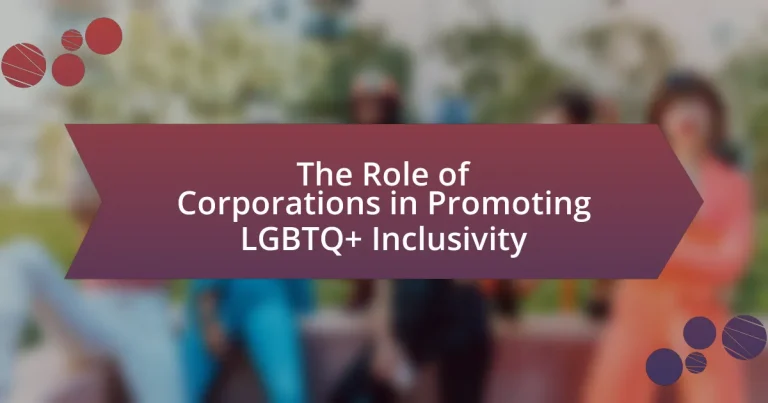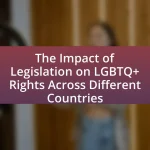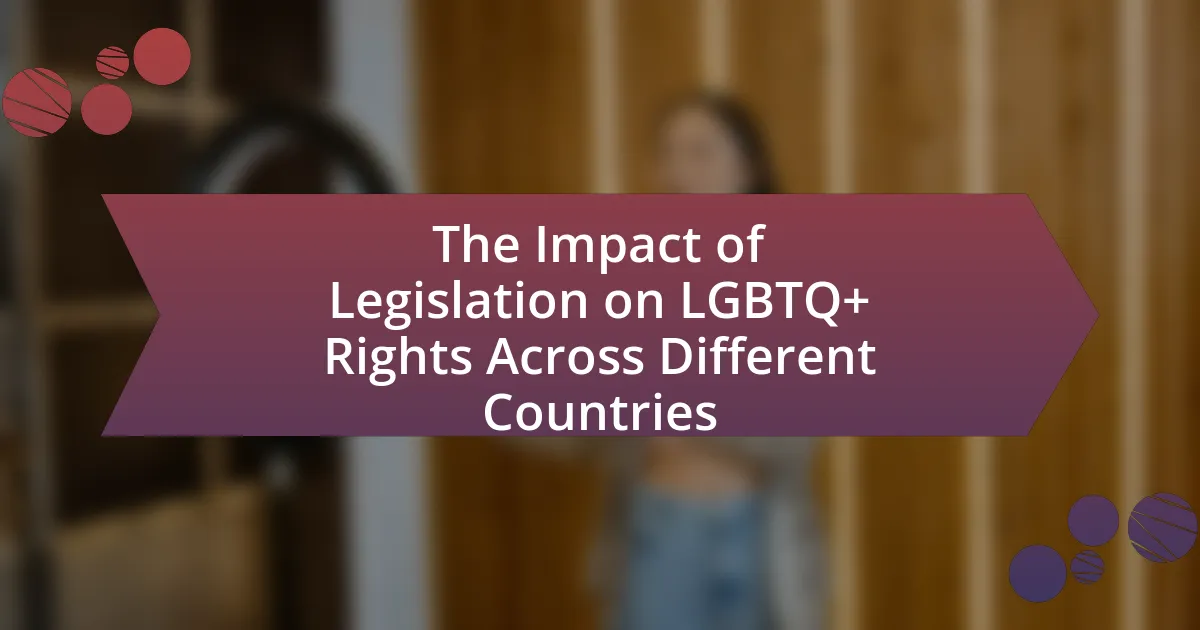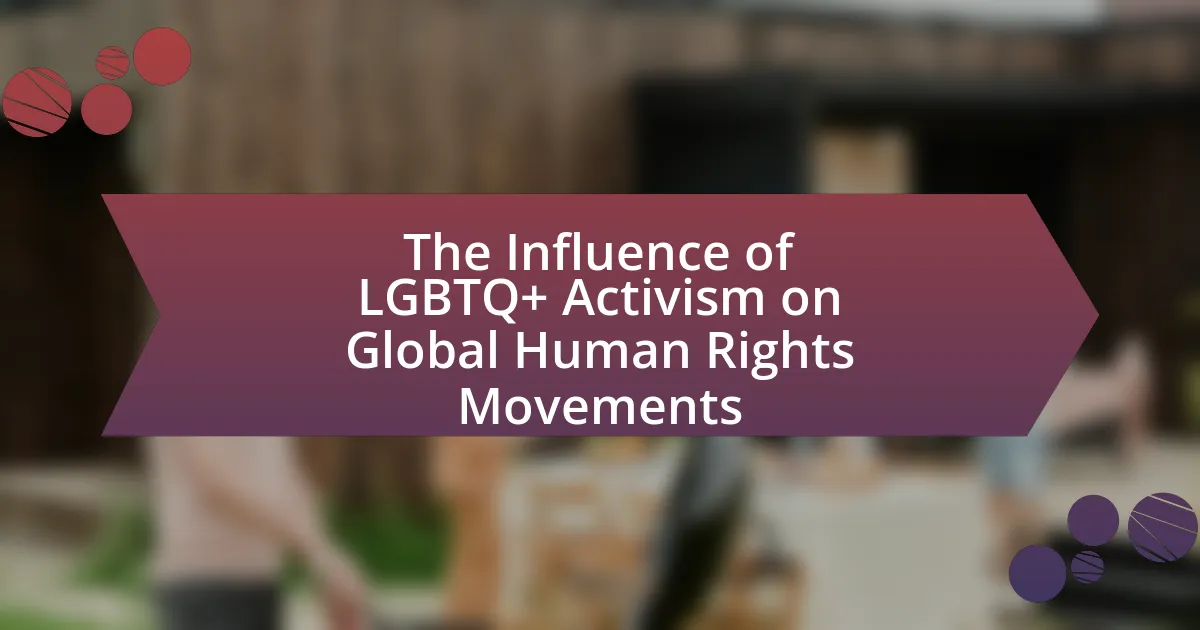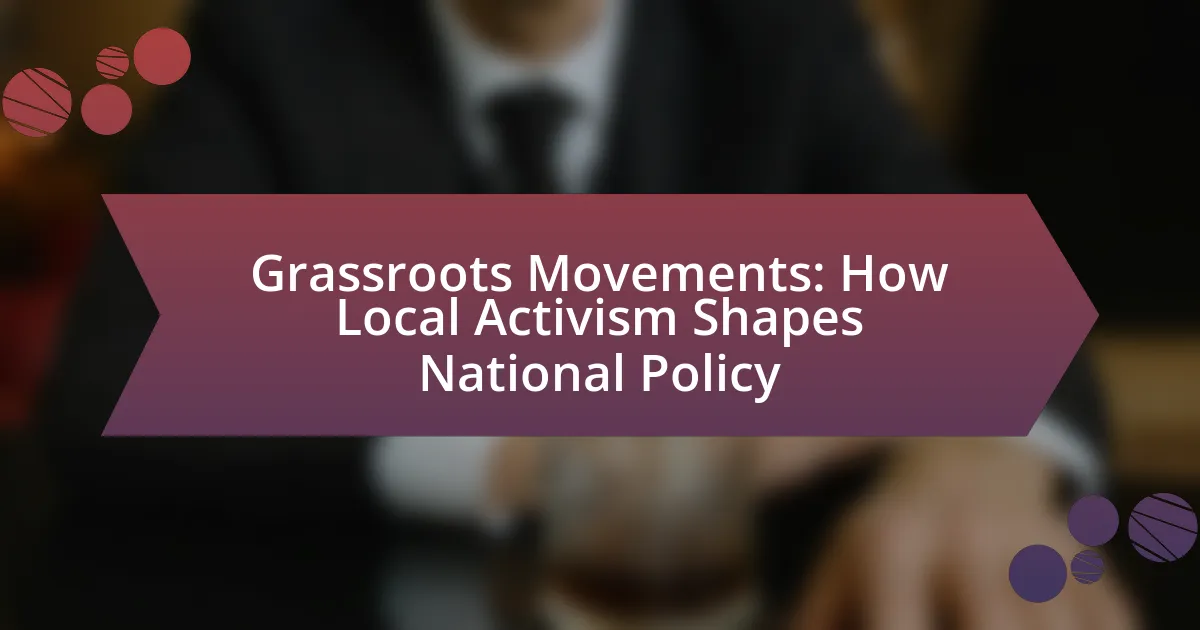The article examines the critical role of corporations in promoting LGBTQ+ inclusivity within the workplace. It highlights the implementation of inclusive policies, such as non-discrimination clauses and employee resource groups, which foster a diverse and equitable environment. The discussion includes the importance of LGBTQ+ inclusivity for enhancing corporate culture, employee satisfaction, and financial performance, as well as the challenges corporations face in this endeavor. Additionally, it outlines effective strategies for promoting inclusivity, measuring its impact, and the evolving expectations of consumers regarding corporate responsibility in supporting LGBTQ+ rights.

What is the Role of Corporations in Promoting LGBTQ+ Inclusivity?
Corporations play a crucial role in promoting LGBTQ+ inclusivity by implementing policies that foster a diverse and equitable workplace. These policies often include non-discrimination clauses, employee resource groups, and comprehensive benefits that support LGBTQ+ employees, such as healthcare coverage for same-sex partners and gender-affirming care. For instance, a 2021 report by the Human Rights Campaign found that 90% of Fortune 500 companies have adopted non-discrimination policies based on sexual orientation, demonstrating a significant commitment to inclusivity. Additionally, corporations often engage in public advocacy for LGBTQ+ rights, contributing to societal change and visibility. This multifaceted approach not only enhances employee morale and retention but also positively impacts brand reputation and customer loyalty.
Why is LGBTQ+ inclusivity important for corporations?
LGBTQ+ inclusivity is important for corporations because it fosters a diverse and innovative workplace, leading to improved employee satisfaction and productivity. Research indicates that companies with inclusive cultures are 1.7 times more likely to be innovation leaders in their market, as diverse teams bring varied perspectives that enhance problem-solving and creativity. Furthermore, a study by McKinsey & Company found that organizations with higher diversity levels are 35% more likely to outperform their competitors financially. By embracing LGBTQ+ inclusivity, corporations not only enhance their brand reputation but also attract and retain top talent, ultimately driving business success.
How does LGBTQ+ inclusivity impact corporate culture?
LGBTQ+ inclusivity positively impacts corporate culture by fostering a diverse and supportive work environment. Companies that embrace LGBTQ+ inclusivity often experience higher employee morale, increased creativity, and improved retention rates. Research from McKinsey & Company indicates that organizations with diverse workforces are 35% more likely to outperform their peers in terms of financial returns. Furthermore, a study by the Human Rights Campaign found that 90% of LGBTQ+ employees reported feeling more engaged and productive in inclusive workplaces. This demonstrates that LGBTQ+ inclusivity not only enhances corporate culture but also drives business success.
What are the potential benefits of LGBTQ+ inclusivity for businesses?
LGBTQ+ inclusivity offers businesses several potential benefits, including enhanced employee satisfaction, increased innovation, and improved financial performance. Companies that embrace diversity often experience higher levels of employee engagement, leading to lower turnover rates; for instance, a study by McKinsey & Company found that organizations with diverse workforces are 35% more likely to outperform their peers in terms of financial returns. Furthermore, inclusive environments foster creativity and innovation, as diverse teams bring varied perspectives that can lead to unique solutions and products. Additionally, businesses that actively promote LGBTQ+ inclusivity can enhance their brand reputation, attracting a broader customer base; research from the Williams Institute indicates that LGBTQ+ consumers represent a significant market segment with substantial purchasing power.
How do corporations currently promote LGBTQ+ inclusivity?
Corporations currently promote LGBTQ+ inclusivity through various initiatives such as implementing inclusive workplace policies, supporting LGBTQ+ organizations, and participating in Pride events. Many companies have adopted non-discrimination policies that explicitly include sexual orientation and gender identity, fostering a more welcoming environment. For instance, a 2021 report by the Human Rights Campaign found that 91% of Fortune 500 companies have non-discrimination policies that protect LGBTQ+ employees. Additionally, corporations often provide sponsorships and funding to LGBTQ+ advocacy groups, enhancing community support and visibility. By actively engaging in Pride celebrations, companies not only show solidarity but also demonstrate their commitment to inclusivity, which can positively impact their brand reputation and employee morale.
What initiatives are commonly implemented by corporations?
Corporations commonly implement initiatives such as diversity training, employee resource groups, inclusive hiring practices, and support for LGBTQ+ advocacy organizations. These initiatives aim to create a more inclusive workplace environment and promote equality. For instance, a 2020 report by the Human Rights Campaign found that 90% of Fortune 500 companies have adopted non-discrimination policies that include sexual orientation and gender identity, demonstrating a commitment to LGBTQ+ inclusivity. Additionally, many corporations participate in Pride events and offer benefits that support LGBTQ+ employees, further solidifying their role in promoting inclusivity.
How do corporations engage with LGBTQ+ communities?
Corporations engage with LGBTQ+ communities through various initiatives, including sponsorship of pride events, implementing inclusive workplace policies, and supporting LGBTQ+ advocacy organizations. For instance, many companies participate in Pride Month celebrations by sponsoring parades and events, which not only raises awareness but also demonstrates their commitment to inclusivity. Additionally, corporations often establish internal policies that promote diversity, such as non-discrimination clauses and employee resource groups, which foster a supportive environment for LGBTQ+ employees. Furthermore, financial contributions to LGBTQ+ advocacy groups, such as the Human Rights Campaign, help advance rights and visibility for the community. These actions reflect a broader trend where 92% of Fortune 500 companies have adopted non-discrimination policies based on sexual orientation, showcasing a significant corporate commitment to LGBTQ+ inclusivity.
What challenges do corporations face in promoting LGBTQ+ inclusivity?
Corporations face several challenges in promoting LGBTQ+ inclusivity, including resistance from employees and customers, lack of comprehensive policies, and insufficient training. Resistance can stem from cultural biases or fear of backlash, which can hinder the implementation of inclusive practices. Additionally, many corporations lack clear policies that address LGBTQ+ issues, leading to inconsistencies in how inclusivity is approached. Insufficient training for management and staff on LGBTQ+ issues can result in misunderstandings and perpetuation of stereotypes, further complicating efforts to create an inclusive environment. These challenges can ultimately affect employee morale and retention, as well as the corporation’s public image.
What are the common barriers to effective inclusivity initiatives?
Common barriers to effective inclusivity initiatives include lack of leadership commitment, insufficient training, and inadequate resources. Leadership commitment is crucial; without it, initiatives often lack direction and support, leading to ineffective implementation. Insufficient training can result in employees not understanding inclusivity principles, which hinders their ability to foster an inclusive environment. Additionally, inadequate resources, such as funding and personnel, limit the scope and impact of inclusivity programs, making it difficult to achieve meaningful change. These barriers collectively impede the progress of inclusivity initiatives within corporations.
How can corporations overcome resistance to LGBTQ+ inclusivity?
Corporations can overcome resistance to LGBTQ+ inclusivity by implementing comprehensive diversity training programs that educate employees about the importance of inclusivity and the benefits it brings to the workplace. Research indicates that organizations with diversity training see a 20% increase in employee engagement and a 15% increase in overall productivity. Additionally, establishing clear policies that protect LGBTQ+ rights and promote a culture of acceptance can significantly reduce resistance. For instance, companies that have adopted non-discrimination policies report higher retention rates among LGBTQ+ employees, demonstrating the effectiveness of such measures. Engaging leadership in visible support for LGBTQ+ initiatives also fosters an inclusive environment, as studies show that leadership commitment is a key factor in successful diversity efforts.
How can corporations measure the effectiveness of their inclusivity efforts?
Corporations can measure the effectiveness of their inclusivity efforts through employee surveys, diversity metrics, and retention rates. Employee surveys provide direct feedback on the perceived inclusivity of the workplace, allowing corporations to gauge employee sentiment and identify areas for improvement. Diversity metrics, such as the representation of LGBTQ+ individuals in various levels of the organization, offer quantifiable data on progress towards inclusivity goals. Retention rates of LGBTQ+ employees can indicate whether the workplace environment is supportive and welcoming, as higher retention rates often correlate with effective inclusivity initiatives. These methods collectively provide a comprehensive view of how well a corporation is fostering an inclusive environment for LGBTQ+ individuals.
What metrics are used to assess LGBTQ+ inclusivity in the workplace?
Metrics used to assess LGBTQ+ inclusivity in the workplace include employee surveys, representation statistics, retention rates, and diversity training participation. Employee surveys gauge perceptions of inclusivity and identify areas for improvement, while representation statistics track the percentage of LGBTQ+ individuals in various roles and levels within the organization. Retention rates measure how well the workplace supports LGBTQ+ employees, indicating whether they feel valued and included. Additionally, diversity training participation reflects the organization’s commitment to educating staff about LGBTQ+ issues and fostering an inclusive environment. These metrics provide a comprehensive view of how effectively a corporation promotes LGBTQ+ inclusivity.
How can feedback from employees shape inclusivity strategies?
Feedback from employees can significantly shape inclusivity strategies by providing insights into their experiences and perceptions regarding workplace culture. When employees share their thoughts on inclusivity, organizations can identify gaps in their current policies and practices, allowing for targeted improvements. For instance, a study by McKinsey & Company found that companies with diverse workforces are 35% more likely to outperform their peers, highlighting the importance of understanding employee feedback to foster an inclusive environment. By actively soliciting and acting on this feedback, corporations can create strategies that not only address the needs of LGBTQ+ employees but also enhance overall workplace morale and productivity.

What are the best practices for corporations to enhance LGBTQ+ inclusivity?
Corporations can enhance LGBTQ+ inclusivity by implementing comprehensive diversity training programs, establishing clear anti-discrimination policies, and fostering an inclusive workplace culture. Diversity training programs educate employees about LGBTQ+ issues, promoting understanding and respect, which can lead to a more supportive environment. Clear anti-discrimination policies protect LGBTQ+ employees from bias and harassment, ensuring their rights are upheld. Additionally, fostering an inclusive culture involves celebrating LGBTQ+ events, forming employee resource groups, and actively engaging in community outreach, which can improve employee morale and retention. Research from the Human Rights Campaign indicates that companies with inclusive policies see higher employee satisfaction and productivity, demonstrating the effectiveness of these practices.
How can training and education improve LGBTQ+ inclusivity in the workplace?
Training and education can significantly improve LGBTQ+ inclusivity in the workplace by fostering awareness, understanding, and acceptance among employees. Effective training programs educate staff about LGBTQ+ identities, issues, and the importance of inclusivity, which can reduce biases and stereotypes. Research from the Human Rights Campaign indicates that companies with comprehensive diversity training see a 20% increase in employee engagement and a 30% reduction in workplace discrimination complaints. Furthermore, education initiatives can create a supportive environment where LGBTQ+ employees feel safe to express their identities, leading to higher retention rates and overall job satisfaction.
What types of training programs are most effective?
Diversity and inclusion training programs are the most effective types of training programs for promoting LGBTQ+ inclusivity in corporations. These programs typically include workshops that educate employees about LGBTQ+ issues, foster empathy, and encourage allyship. Research indicates that organizations implementing comprehensive diversity training see a 30% increase in employee engagement and a 25% reduction in workplace discrimination incidents. For example, a study by the Human Rights Campaign found that companies with robust diversity training programs reported higher levels of employee satisfaction and retention among LGBTQ+ employees.
How can ongoing education foster a more inclusive environment?
Ongoing education fosters a more inclusive environment by equipping individuals with knowledge and awareness about diverse identities and experiences, particularly within the LGBTQ+ community. This education can take the form of training programs, workshops, and resources that address topics such as unconscious bias, cultural competency, and the importance of allyship. Research indicates that organizations that implement comprehensive diversity training see a significant increase in employee engagement and a reduction in discriminatory behaviors. For instance, a study by the Human Rights Campaign found that companies with LGBTQ+ inclusive training programs reported a 30% increase in employee satisfaction and a 25% decrease in workplace harassment incidents. By continuously educating employees, corporations can create a culture of respect and understanding, ultimately leading to a more inclusive environment.
What role does leadership play in promoting LGBTQ+ inclusivity?
Leadership plays a crucial role in promoting LGBTQ+ inclusivity by establishing a culture of acceptance and support within organizations. Effective leaders advocate for inclusive policies, such as non-discrimination practices and diversity training, which create a safe environment for LGBTQ+ employees. Research from the Human Rights Campaign indicates that companies with inclusive leadership see higher employee satisfaction and retention rates, demonstrating the positive impact of leadership on workplace culture. Furthermore, leaders who publicly support LGBTQ+ rights can influence broader societal attitudes, reinforcing the importance of inclusivity beyond the workplace.
How can leaders model inclusive behavior?
Leaders can model inclusive behavior by actively promoting diversity and creating an environment where all individuals feel valued and respected. This can be achieved through implementing policies that support equal opportunities, providing diversity training, and encouraging open dialogue about inclusivity. Research shows that organizations with inclusive leadership practices experience higher employee engagement and retention rates, as highlighted in a study by McKinsey & Company, which found that diverse teams are 35% more likely to outperform their peers. By demonstrating commitment to inclusivity, leaders not only foster a positive workplace culture but also drive better business outcomes.
What strategies can leaders use to advocate for LGBTQ+ rights within their organizations?
Leaders can advocate for LGBTQ+ rights within their organizations by implementing inclusive policies, fostering a supportive culture, and providing training on diversity and inclusion. Inclusive policies, such as non-discrimination clauses and benefits for same-sex partners, create a legal framework that protects LGBTQ+ employees. A supportive culture can be cultivated through visible leadership commitment, such as participating in LGBTQ+ events and promoting employee resource groups. Additionally, training programs that educate employees about LGBTQ+ issues and unconscious bias can enhance understanding and acceptance. Research indicates that organizations with inclusive practices experience higher employee satisfaction and retention rates, demonstrating the effectiveness of these strategies in promoting LGBTQ+ rights.
What partnerships can corporations form to support LGBTQ+ inclusivity?
Corporations can form partnerships with LGBTQ+ advocacy organizations, educational institutions, and community groups to support LGBTQ+ inclusivity. Collaborating with organizations such as the Human Rights Campaign or GLAAD allows corporations to access resources, training, and expertise in creating inclusive workplaces. Additionally, partnerships with educational institutions can facilitate awareness programs and scholarships for LGBTQ+ students, promoting diversity in the workforce. Engaging with local community groups can help corporations understand specific needs and challenges faced by LGBTQ+ individuals, fostering a more inclusive environment. These partnerships not only enhance corporate social responsibility but also improve employee morale and attract diverse talent, as evidenced by studies showing that inclusive workplaces lead to higher employee satisfaction and retention rates.
How can collaborations with LGBTQ+ organizations enhance corporate initiatives?
Collaborations with LGBTQ+ organizations can enhance corporate initiatives by fostering a more inclusive workplace culture and improving brand reputation. These partnerships provide corporations with insights into the unique challenges faced by LGBTQ+ individuals, enabling them to develop targeted policies and programs that promote diversity and inclusion. For instance, companies that actively engage with LGBTQ+ organizations often see increased employee satisfaction and retention rates, as employees feel valued and supported. Research from the Human Rights Campaign indicates that inclusive workplaces can lead to a 20% increase in employee performance. Additionally, brands that align with LGBTQ+ causes can attract a broader customer base, as 70% of LGBTQ+ consumers prefer to purchase from companies that support their community.
What are the benefits of community engagement for corporations?
Community engagement provides corporations with enhanced brand reputation, increased customer loyalty, and improved employee morale. By actively participating in community initiatives, corporations demonstrate social responsibility, which can lead to a positive public image. For instance, a study by Cone Communications found that 87% of consumers are more likely to purchase from a company that supports social causes. Additionally, community engagement fosters stronger relationships with local stakeholders, which can result in valuable partnerships and networking opportunities. Engaging with the community also boosts employee satisfaction, as employees often feel more motivated and proud to work for a socially responsible organization. This is supported by research from Deloitte, which indicates that companies with strong community engagement programs have 50% higher employee retention rates.

What future trends are emerging in corporate LGBTQ+ inclusivity efforts?
Future trends in corporate LGBTQ+ inclusivity efforts include increased focus on intersectionality, mental health support, and comprehensive policy reforms. Corporations are recognizing the importance of addressing the diverse experiences within the LGBTQ+ community, leading to initiatives that consider race, gender identity, and socioeconomic status. Additionally, mental health resources tailored for LGBTQ+ employees are becoming a priority, as studies show that this community faces higher rates of mental health challenges. Furthermore, companies are implementing more robust anti-discrimination policies and inclusive benefits, reflecting a commitment to creating safe and supportive work environments. These trends are supported by research indicating that inclusive workplaces enhance employee satisfaction and retention, ultimately benefiting organizational performance.
How is technology influencing LGBTQ+ inclusivity in the workplace?
Technology is significantly enhancing LGBTQ+ inclusivity in the workplace by facilitating communication, promoting awareness, and providing resources for support. Digital platforms enable employees to connect with LGBTQ+ communities, fostering a sense of belonging and acceptance. For instance, companies are increasingly using online training modules to educate staff about diversity and inclusion, which has been shown to improve workplace culture. A study by McKinsey & Company found that organizations with diverse workforces are 35% more likely to outperform their peers, highlighting the business benefits of inclusivity. Additionally, technology allows for anonymous reporting tools, enabling employees to voice concerns about discrimination without fear of retaliation, thus creating a safer environment for LGBTQ+ individuals.
What digital tools can support inclusivity initiatives?
Digital tools that can support inclusivity initiatives include collaboration platforms, accessibility software, and social media engagement tools. Collaboration platforms like Microsoft Teams and Slack facilitate communication among diverse teams, ensuring that all voices are heard. Accessibility software, such as screen readers and captioning tools, helps individuals with disabilities participate fully in digital environments. Social media engagement tools enable organizations to promote inclusivity campaigns and connect with LGBTQ+ communities effectively. These tools collectively enhance participation and representation, fostering a more inclusive corporate culture.
How can data analytics improve understanding of inclusivity needs?
Data analytics can improve understanding of inclusivity needs by providing insights into demographic trends, employee feedback, and engagement metrics. By analyzing data from surveys, social media, and internal reports, organizations can identify gaps in inclusivity and tailor their policies to better support diverse groups. For instance, a study by McKinsey & Company found that companies with diverse workforces are 35% more likely to outperform their peers, highlighting the importance of understanding inclusivity needs through data. This evidence demonstrates that leveraging data analytics not only enhances awareness of inclusivity issues but also drives strategic initiatives that foster a more inclusive workplace.
What are the evolving expectations of consumers regarding corporate inclusivity?
Consumers increasingly expect corporations to demonstrate genuine commitment to inclusivity, particularly regarding LGBTQ+ rights. This expectation is driven by a growing awareness of social justice issues and a demand for accountability from brands. According to a 2021 report by McKinsey & Company, 67% of consumers prefer to buy from companies that actively support diversity and inclusion initiatives. Furthermore, consumers are more likely to engage with brands that reflect their values, with 76% of LGBTQ+ individuals stating they would switch to a brand that supports their community. This shift indicates that inclusivity is not just a marketing strategy but a fundamental expectation for consumer loyalty and brand reputation.
How do consumer preferences impact corporate policies on LGBTQ+ inclusivity?
Consumer preferences significantly influence corporate policies on LGBTQ+ inclusivity by driving companies to adopt more inclusive practices to meet market demands. As consumers increasingly prioritize diversity and inclusivity in their purchasing decisions, corporations respond by implementing policies that promote LGBTQ+ rights and representation. For instance, a 2021 report by the Human Rights Campaign found that 76% of LGBTQ+ consumers are more likely to support brands that actively promote LGBTQ+ equality, demonstrating a clear link between consumer expectations and corporate behavior. This trend compels companies to not only adopt inclusive policies but also to engage in marketing strategies that resonate with LGBTQ+ communities, ultimately shaping their corporate identity and values.
What role does social media play in shaping public perception of corporate inclusivity?
Social media significantly influences public perception of corporate inclusivity by providing a platform for dialogue, transparency, and accountability. Corporations that actively engage with their audiences on social media can showcase their inclusivity initiatives, such as LGBTQ+ support programs, which can enhance their reputation. For instance, a 2021 study by the Human Rights Campaign found that 76% of LGBTQ+ individuals are more likely to support brands that demonstrate a commitment to inclusivity on social media. This demonstrates that social media not only amplifies corporate messages but also allows consumers to hold companies accountable for their inclusivity practices, thereby shaping public perception effectively.
What practical steps can corporations take to enhance LGBTQ+ inclusivity?
Corporations can enhance LGBTQ+ inclusivity by implementing comprehensive diversity training programs that educate employees about LGBTQ+ issues and promote allyship. Research indicates that organizations with diversity training see a 20% increase in employee engagement and a 15% increase in retention rates among LGBTQ+ employees. Additionally, corporations should establish clear anti-discrimination policies that explicitly include sexual orientation and gender identity, as companies with such policies report a 30% decrease in workplace discrimination claims. Furthermore, creating employee resource groups (ERGs) for LGBTQ+ employees fosters a supportive community and encourages open dialogue, leading to a more inclusive workplace culture. Lastly, corporations can actively participate in LGBTQ+ events and partnerships, demonstrating their commitment to inclusivity and enhancing their brand reputation within the LGBTQ+ community.
What immediate actions can be implemented to foster inclusivity?
Implementing immediate actions to foster inclusivity involves establishing comprehensive diversity training programs for all employees. These programs educate staff on LGBTQ+ issues, promote understanding, and reduce biases, creating a more inclusive workplace environment. Research from the Human Rights Campaign indicates that companies with diversity training see a 30% increase in employee engagement and satisfaction. Additionally, corporations can implement inclusive policies, such as non-discrimination clauses and support for LGBTQ+ employee resource groups, which have been shown to enhance workplace culture and retention rates.
How can corporations create a long-term strategy for LGBTQ+ inclusivity?
Corporations can create a long-term strategy for LGBTQ+ inclusivity by implementing comprehensive policies that promote equality, provide training, and foster an inclusive culture. Establishing non-discrimination policies that explicitly include sexual orientation and gender identity is essential, as evidenced by the Human Rights Campaign’s Corporate Equality Index, which shows that companies with such policies report higher employee satisfaction and retention rates. Additionally, offering diversity training programs can educate employees about LGBTQ+ issues, reducing bias and fostering understanding. Regularly assessing the workplace environment through surveys and feedback mechanisms ensures that the inclusivity strategy evolves based on employee needs and societal changes. By actively engaging with LGBTQ+ organizations and communities, corporations can demonstrate their commitment and gain insights into best practices for inclusivity.
